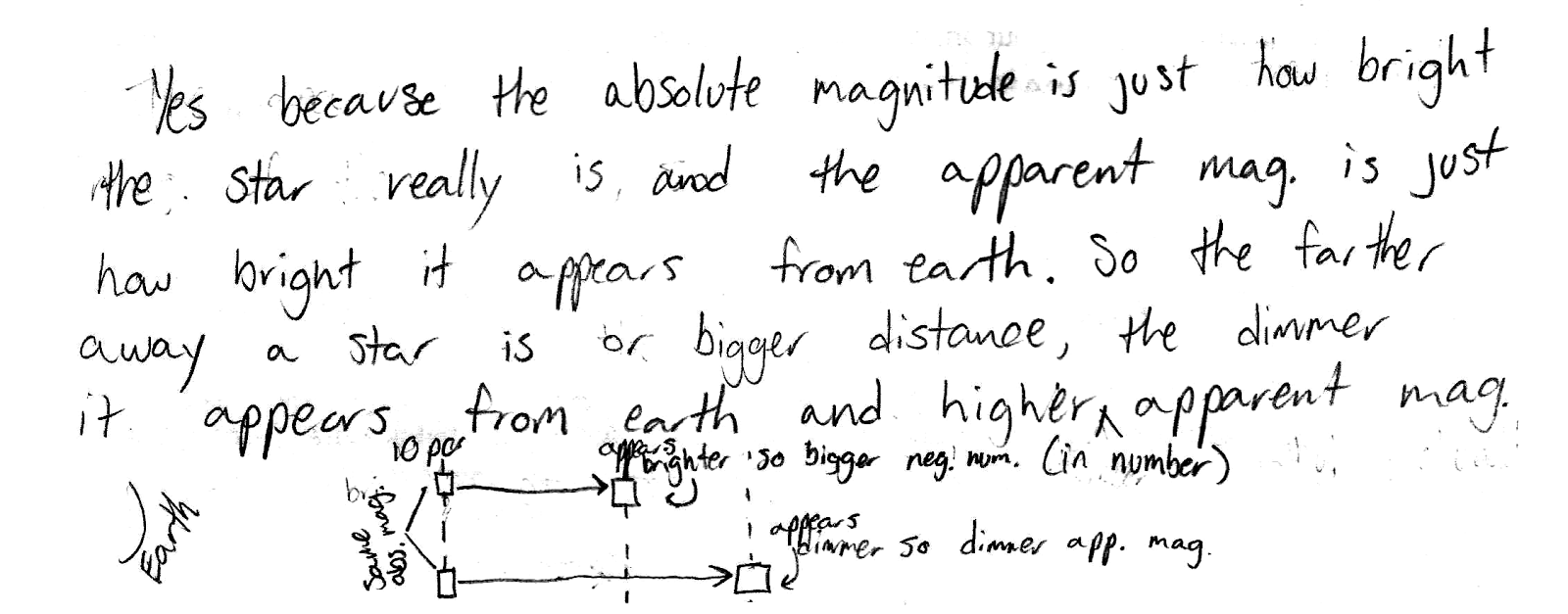Cuesta College, San Luis Obispo, CA
An astronomy question on an online discussion board[*] was asked and answered:
Pdg: Can two stars have the same absolute magnitude, if they both have different distances farther than 10 parsecs?Discuss whether this answer is correct or incorrect, and how you know this. Explain using the relationships between apparent magnitude, absolute magnitude, and distance.
pub: Yes, if the nearer star has a brighter apparent magnitude (bigger negative number, or smaller positive number), and the farther star has a dimmer apparent magnitude.
[*] answers.yahoo.com/question/index?qid=20170305023512AAeRXO8.
Solution and grading rubric:
- p:
Correct. Understands difference between apparent magnitude m (brightness as seen from Earth, when placed at their actual distance from Earth) and absolute magnitude M (brightness as seen from Earth, when placed at the "fair comparison distance" of 10 parsecs away), and discusses:- a star at 10 parsecs away with a certain absolute magnitude will get dimmer when placed further than 10 parsecs away from Earth, and thus its apparent magnitude will be dimmer than its absolute magnitude; and
- since both stars have the same absolute magnitude at 10 parsecs, the nearer star would be located just a little farther away from 10 parsecs, resulting in a slightly dimmer apparent magnitude, while the farther star would be located much farther away from 10 parsecs, resulting in a much dimmer apparent magnitude.
- r:
Nearly correct (explanation weak, unclear or only nearly complete); includes extraneous/tangential information; or has minor errors. May have one star located closer than 10 parsecs, or moving in the wrong direction to change its apparent magnitude to its absolute magnitude. - t:
Contains right ideas, but discussion is unclear/incomplete or contains major errors. At least discussion demonstrates understanding of relationships between apparent magnitudes, absolute magnitudes, and distances. - v:
Limited relevant discussion of supporting evidence of at least some merit, but in an inconsistent or unclear manner. At least attempts to use relationships between apparent magnitudes, absolute magnitudes, and distances. - x:
Implementation/application of ideas, but credit given for effort rather than merit. Discussion based on garbled definitions of, or not based on proper relationships between apparent magnitudes, absolute magnitudes, and distances. - y:
Irrelevant discussion/effectively blank. - z:
Blank.
Section 30676
Exam code: midterm02sL0w
p: 18 students
r: 6 students
t: 4 students
v: 9 students
x: 6 students
y: 0 students
z: 0 students
A sample "p" response (from student 0428):

Another sample "p" response (from student 0511):

No comments:
Post a Comment